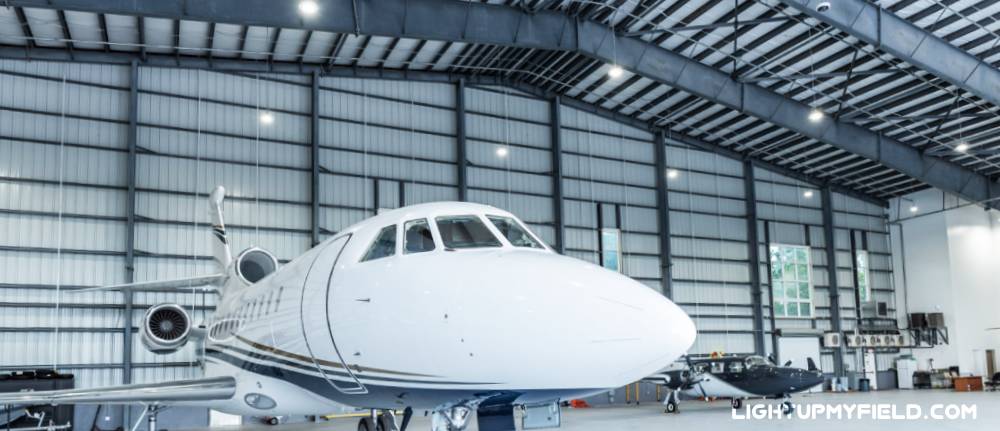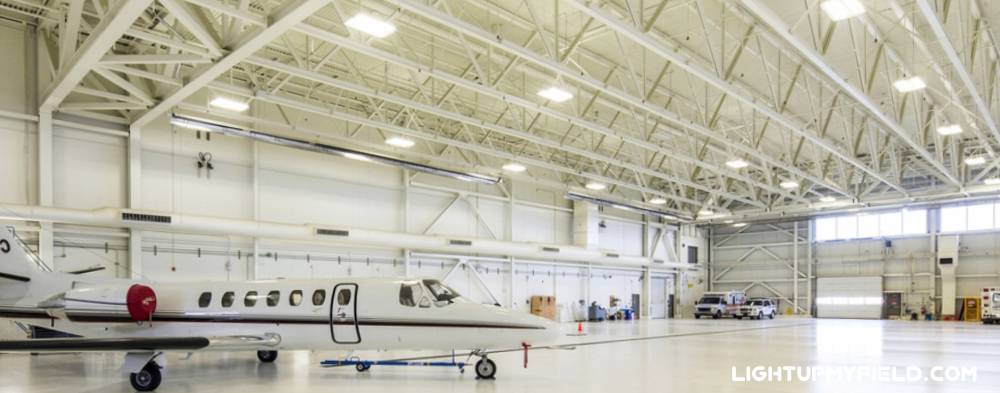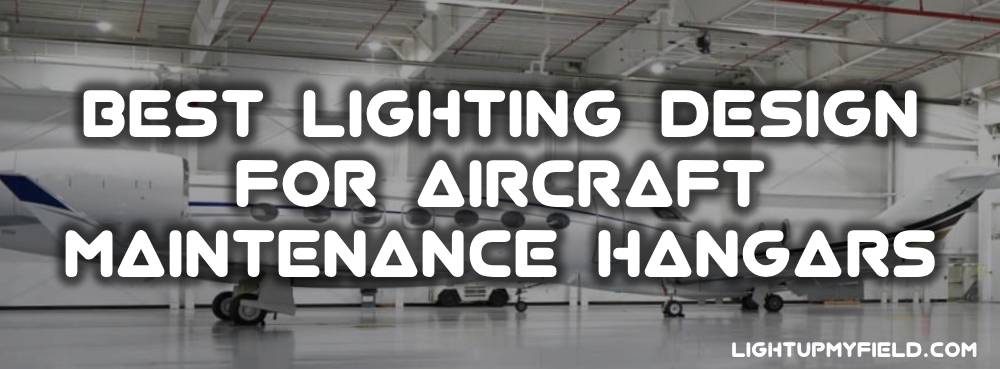Designing the right lighting for an aircraft hangar isn’t just about putting up a few bright fixtures and calling it a day. These are huge spaces with unique challenges—massive ceilings, reflective aircraft surfaces, and areas where precise inspections happen every day. The lighting system has to support safety, accuracy, and efficiency, all while keeping energy costs in check. Let’s dive into what makes a hangar lighting setup truly effective.
Table of Contents
ToggleLighting Design Principles
Color Temperature – Why It Matters More Than You Think
Color temperature sounds like one of those details that only lighting geeks care about, but in a hangar, it can make a world of difference. The sweet spot for most aircraft maintenance hangars is between 4000K and 5000K. That range gives you a clean, neutral white light—bright enough to see every detail without feeling overly harsh.
Why not go for a warmer tone, like 3000K? Because warmer light can distort color perception and make fine details harder to pick up. Imagine trying to spot oil leaks or surface damage under a yellowish hue—not ideal. On the flip side, going above 5000K drifts into that bluish daylight tone, which can feel too cold and fatiguing during long shifts.
If you want the best balance, stick around 4500K. It keeps the space crisp and clear without straining the eyes, even after hours of maintenance work.

Lux and Footcandle Requirements – It’s All About the Numbers
Lighting a hangar isn’t a guessing game; you can’t just eyeball what feels “bright enough.” It comes down to measurable targets like lux and footcandles.
For heavy-duty maintenance areas, FAA and ICAO recommend about 500 lux (roughly 46 foot-candles). That’s a lot brighter than a standard office, which usually sits at around 300 lux. For walkways, storage zones, or general movement areas, you can dial it down to about 200–300 lux (18–28 fc).
To put this in perspective: if your design only delivers 200 lux in a maintenance zone where 500 is needed, studies show inspection error rates can jump by 20–30%. That’s not just a headache—it means longer downtime and potentially higher costs if issues slip through unnoticed.
Lighting Uniformity – No More Bright and Dark Patches
Ever walked from a bright zone into a dim one and felt your eyes struggling to adjust? That’s what happens with uneven lighting. In hangars, the goal is a uniformity ratio of 3:1 or better, meaning the brightest spot shouldn’t be more than three times brighter than the darkest.
For example, if one area reads 600 lux, the adjacent darker spots should still hit at least 200 lux. This avoids harsh contrasts and reduces eye strain, helping mechanics spot tiny flaws without constantly adjusting their vision.
Ceiling Height – Why It Changes Everything
Hangars aren’t your average rooms—they’re massive. Ceiling heights often range from 30 feet to 60 feet or more, and that changes how you light the place. The higher the mounting height, the more powerful your fixtures need to be.
You’ll often see high-bay LEDs pumping out 30,000 to 60,000 lumens each in these spaces. But raw output isn’t everything. At 50 feet up, a narrow beam might just create a small bright circle on the floor, while a wide beam spreads the light out for more uniform coverage. Picking the right optics can make or break your design.

Light Spacing and How Many Lights Do You Really Need?
Here’s the big question: how far apart should the lights be? Most designers use something called the Spacing-to-Mounting Height Ratio (SMHR), usually between 0.8 and 1.2.
So, if your fixtures are mounted at 50 feet, your spacing should land between 40 feet and 60 feet apart. Push them farther and you’ll see dark zones. Bring them closer and you waste energy and increase glare.
Beam angle also plays a role. A 90° beam gives you more coverage and wider spacing, while a 60° beam is better for concentrated lighting but requires tighter spacing. To light a 100,000 sq. ft. hangar at 500 lux, you’re typically looking at 80 to 120 LED high-bay fixtures, depending on wattage, optics, and surface reflectivity.
Wattage – Balancing Power and Efficiency
Modern LEDs make this easy because they deliver huge lumen output at lower wattages. Most high-bay LEDs for hangars range from 250 to 600 watts, giving you anywhere from 30,000 to 60,000 lumens. Compare that to old metal halide fixtures that needed 1,000 watts or more to hit similar brightness levels.
Lower wattage doesn’t just mean energy savings—it means less heat output and longer fixture life, both of which matter when your lights are mounted 50 feet up and running 12–16 hours a day.
Glare Control – Keeping It Comfortable
Glare is a big issue in hangars, thanks to all those shiny aircraft surfaces. Too much glare can cause eye fatigue and visibility problems, especially when workers are inspecting polished metal components.
Solutions include using diffusers, low-UGR fixtures, or reflective baffles. In some cases, designers go for indirect lighting by bouncing light off the ceiling, which creates a softer, more even glow without sacrificing brightness.
Lighting Control – Smarter, Not Just Brighter
Modern hangars don’t just flip lights on and off anymore. They use dimming, motion sensors, and daylight harvesting to keep things efficient. For example, during daylight hours, you can cut output without dropping below lux requirements.
With the right controls, you can save 30–40% on energy costs over time. Zoning is another game-changer—you can light up only the active maintenance zones instead of the entire hangar at full power.
Wiring and Power Supply – Don’t Skimp Here
When your lights are mounted 50 or 60 feet up, you really don’t want to be fixing wiring every few months. Use high-quality cabling rated for high-bay environments and consider separate circuits for different zones, especially if you’re integrating smart controls.
Backup power is another must-have because even a short outage during maintenance can cause big safety issues. Planning for emergency lighting or generator tie-ins keeps your hangar operational when the unexpected happens.
| Aspect | Recommended Values / Notes |
|---|---|
| Color Temperature | 4000K to 5000K (ideal ~4500K for balanced, clear light) |
| Lux / Footcandle Levels | Maintenance zones: ~500 lux (46 fc); Walkways/storage: 200–300 lux (18–28 fc) |
| Uniformity Ratio | 3:1 or better (brightest area max 3x the darkest) |
| Ceiling Height | Usually 30 to 60+ feet; fixtures produce 30,000–60,000 lumens |
| Light Spacing (SMHR) | 0.8 to 1.2 × mounting height (e.g., at 50 ft height → 40–60 ft spacing) |
| Number of Fixtures | For 100,000 sq.ft. hangar at 500 lux: 80–120 LED high-bay lights |
| Wattage per Fixture | 250–600 watts (LEDs) vs. 1000+ watts for older metal halides |
Functions of Hangar Lights

More Than Just Brightness
Hangar lights aren’t just about making a big space look bright—they have a much bigger role. These fixtures are designed to create a safe and efficient work environment where technicians can work with confidence. Think about what happens inside a maintenance hangar: crews are inspecting engine components, checking electrical systems, and spotting tiny surface flaws on an aircraft’s body. A crack as small as 0.02 inches can compromise safety, and if the lighting isn’t up to the job, that crack might go unnoticed.
Supporting Multiple Activities
It’s not just about detailed inspections either. Hangars are busy places with multiple functions happening at once. You have ground vehicles moving around, planes being towed, parts being transported, and even administrative work taking place in certain sections. The lighting needs to strike a balance between task-focused brightness and overall visibility. For example, while maintenance areas need around 500 lux to meet FAA and ICAO recommendations, general movement zones can work with about 200–300 lux. That means your lighting design has to cover everything—from the people replacing engine parts to those simply walking across the floor.
Safety and Productivity Go Hand in Hand
Poor lighting isn’t just inconvenient—it can slow down work or even cause accidents. Studies show that inadequate lighting can reduce productivity by up to 20% because technicians spend extra time adjusting or moving equipment to see better. And when you’re dealing with aircraft that cost millions of dollars, delays can get expensive fast. Beyond that, good lighting reduces the chances of slips, trips, and collisions with equipment, which are real risks in a hangar full of tools and heavy machinery.
Creating a Comfortable Environment
Another often-overlooked role of hangar lighting is crew comfort. Maintenance work can last for hours, sometimes overnight, and harsh or uneven lighting can cause eye strain and fatigue. That’s why designers aim for lighting that’s bright but not glaring, with consistent color temperature and uniform coverage. When the environment is visually comfortable, crews stay alert and focused, which means better work quality and fewer mistakes.
Points to Note and Common Mistakes When Installing Hangar Lights
Skipping the Design Phase

One of the biggest mistakes people make is thinking a simple grid pattern will do the job. Hangars aren’t like warehouses—aircraft take up massive space and create large shadows that a uniform grid can’t always fix. If you just “eyeball it,” you’ll end up with dark corners or overlit patches that waste energy.
That’s why a proper lighting simulation is worth its weight in gold. Tools like DIALux or AGi32 can model the exact layout of your hangar, including aircraft placement, to show how light will actually fall. Spending a little time on design upfront saves you from costly changes later.
Forgetting About Maintenance Access
LEDs are marketed as low-maintenance, and it’s true—they can last 50,000 to 100,000 hours. But “low-maintenance” doesn’t mean zero maintenance. Drivers fail, dust accumulates, and eventually, fixtures need attention.
If your lights are packed too tightly, or worse, installed without any safe catwalk or lift access, you’ve created a nightmare for the maintenance team. Always plan your layout with serviceability in mind. A good rule of thumb? If a technician can’t reach a fixture without specialized gear or disrupting operations, it’s a design fail.
Overlooking Color Rendering Index (CRI)
People often obsess about brightness but ignore color rendering, which can be just as important in a maintenance setting. CRI tells you how accurately a light source shows colors compared to natural light. For hangars, a CRI of 80 or higher is strongly recommended.
Why? Because technicians need to see wiring colors, paint finishes, and surface conditions accurately. A poor CRI can make colors look flat or even mislead the eye, which could lead to costly mistakes during inspection or repair.
Ignoring Glare Control
Ever stepped into a hangar where everything feels uncomfortably bright, almost blinding? That’s what happens when glare isn’t managed. Too many high-output fixtures aimed directly down without diffusers or shielding can create hot spots that cause eye fatigue.
This isn’t just an annoyance—it can slow work and increase error rates. Always choose fixtures with low UGR ratings or add accessories like reflectors and baffles to soften the light. The goal is clear, even lighting, not a harsh spotlight effect.
A Quick Recap
The best hangar lighting design isn’t about just flooding the space with light. It’s about balancing brightness, uniformity, comfort, and energy efficiency. Every detail matters—from spacing and wattage to glare control and smart systems. Get those elements right, and you’ll have a hangar that’s safe, productive, and cost-effective for years to come.

